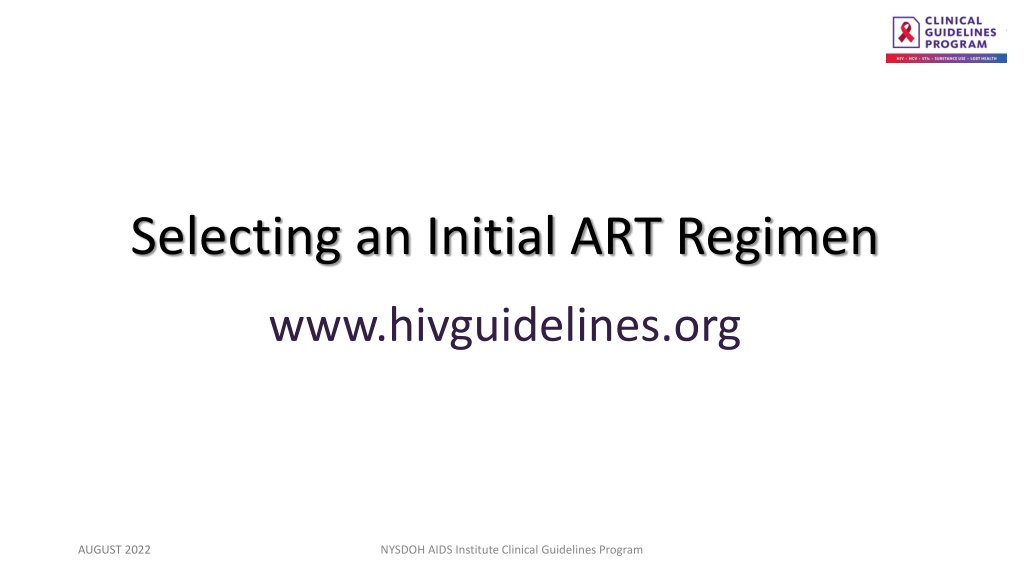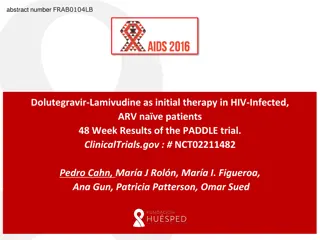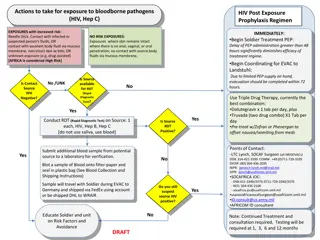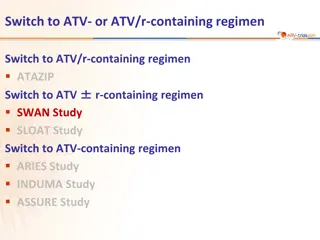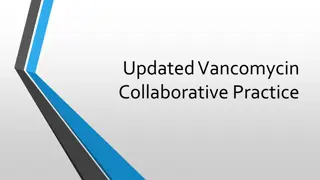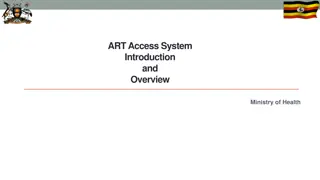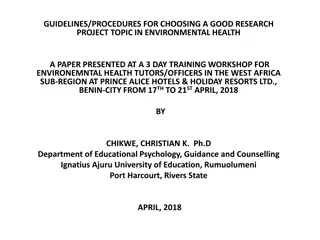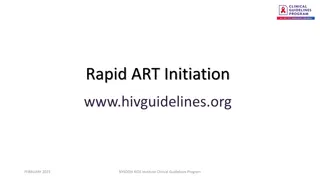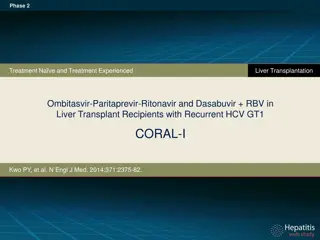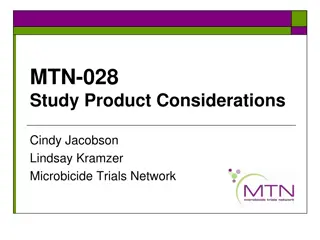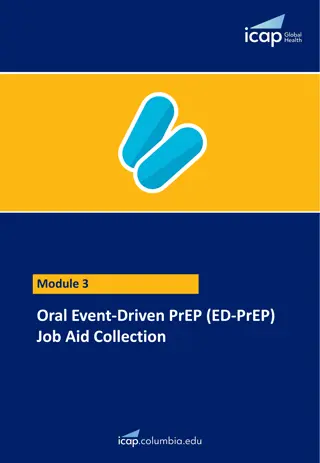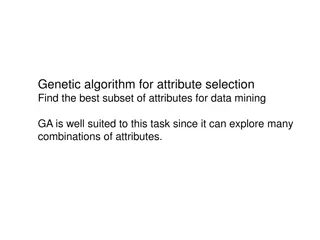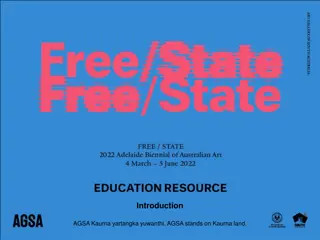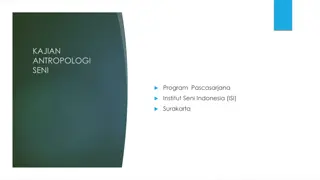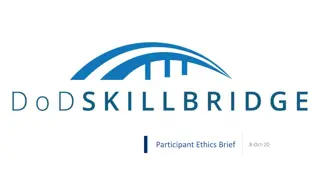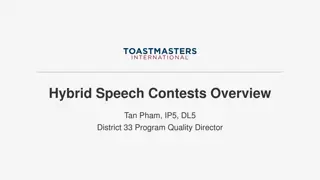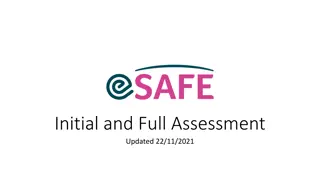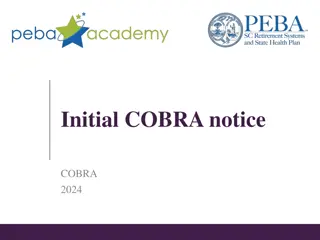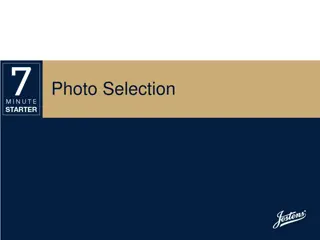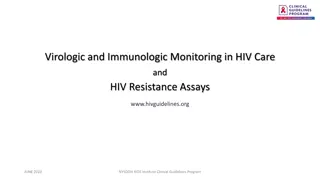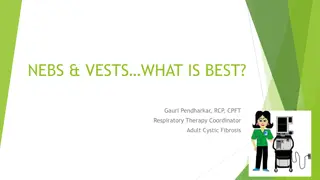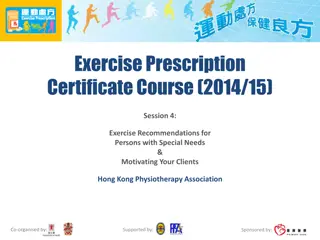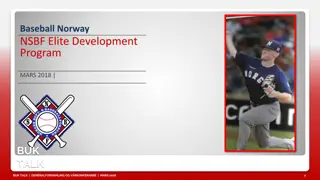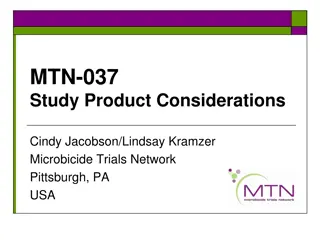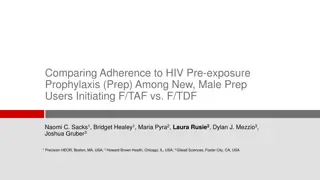Selecting an Initial ART Regimen Guidelines
Guidelines for selecting an initial antiretroviral therapy (ART) regimen include performing genotypic HIV resistance testing, engaging in shared decision-making with patients, considering comorbidities and coadministered medications, and prescribing preferred regimens. Recommendations also include consulting with HIV specialists for complex cases and monitoring patients closely post-treatment initiation.
Download Presentation

Please find below an Image/Link to download the presentation.
The content on the website is provided AS IS for your information and personal use only. It may not be sold, licensed, or shared on other websites without obtaining consent from the author. Download presentation by click this link. If you encounter any issues during the download, it is possible that the publisher has removed the file from their server.
E N D
Presentation Transcript
Selecting an Initial ART Regimen www.hivguidelines.org AUGUST 2022 NYSDOH AIDS Institute Clinical Guidelines Program
Purpose of This Guideline Purpose of This Guideline Provide a clear and concise roadmap for clinicians to follow in choosing from among several equally efficacious ART regimens based on individual patient characteristics and preferences. Provide a list of ART regimens to avoid. Provide dosing considerations for individuals with renal or hepatic impairment and important drug-drug and food interactions. Encourage clinicians to seek the assistance of an experienced HIV care provider when treating patients with extensive comorbidities. Integrate current evidence-based clinical recommendations into the healthcare-related implementation strategies of the New York State Ending the Epidemic initiative. AUGUST 2022 NYSDOH AIDS Institute Clinical Guidelines Program www.hivguidelines.org
Recommendations: Recommendations: Regimen Selection Regimen Selection When selecting an initial ART regimen for treatment naive-patients, clinicians should: Perform genotypic HIV resistance testing results for protease (A2), reverse transcriptase (A2), and integrase (B2) genotypic resistance if the testing has not already been performed or results are not otherwise available. Inform patients of the regimen options and engage in shared decision-making to optimize the likelihood of adherence. (A3) Assess for comorbidities and chronic coadministered medications that may affect the choice of regimen for a patient s initial ART. (A3) Choose a preferred ART regimen unless one of the alternative regimens is a better choice based on individual patient factors. (A1) Recommend a single-tablet regimen or a regimen with once-daily dosing unless those regimens are contraindicated by HIV resistance, drug-drug interactions, intolerance, allergy, or access. (A2) Ask patients about their reproductive plans [a] and discuss the use of contraception. (A3) With the exception of DTG/3TC, clinicians should not prescribe 2-drug regimens as initial ART. (A3) Clinicians should prescribe DTG/3TC only after: HIV resistance and hepatitis B virus (HBV) status are known. (A1) Genotypic resistance testing results have confirmed that a patient does not have a major reverse transcriptase mutation, including the M184V/I resistance mutation. DTG/3TC is contraindicated in patients with these resistance-associated mutations. (A1) AUGUST 2022 NYSDOH AIDS Institute Clinical Guidelines Program www.hivguidelines.org
Recommendations: Recommendations: Expert Consultation & Follow Expert Consultation & Follow- -up up Clinicians should consult with an experienced HIV care provider when selecting an initial ART regimen for a patient who has: Baseline genotypic testing results indicating the need for an ART regimen other than the available preferred or alternative regimens. (A3) Extensive comorbidities, including metabolic complications and obesity; comedications; impaired renal function; HBV or hepatitis C virus coinfection; or active opportunistic infections. (B3) The NYSDOH Clinical Education Initiative provides access to HIV specialists through their toll-free line: 1-866-637-2342. Clinicians or clinical support staff should follow up by telephone or other methods, preferably within 2 weeks after treatment initiation, to assess tolerance and adherence; adherence should be reinforced at regular intervals. (A3) Clinicians should obtain a viral load test within 4 weeks after ART initiation to assess initial response to therapy. (A3) AUGUST 2022 NYSDOH AIDS Institute Clinical Guidelines Program www.hivguidelines.org
Key Points Key Points INSTI-based regimens are generally the best choice for most individuals because of tolerability and durability. Neither mental health nor substance use disorders are contraindications to initiating ART. In some special cases, delay of initiation (for as short a time as possible) may be appropriate while addressing adherence issues and possible interactions. AUGUST 2022 NYSDOH AIDS Institute Clinical Guidelines Program www.hivguidelines.org
Important Clinical Considerations With Either Important Clinical Considerations With Either TDF/FTC or TAF/FTC as Initial ART TDF/FTC or TAF/FTC as Initial ART If the patient is at risk of chronic kidney disease (e.g., age >40 years, with hypertension, diabetes, or preexisting mild kidney disease): Higher rates of renal dysfunction have been reported in individuals taking TDF in conjunction with RTV- and COBI-containing regimens. For people at low risk for kidney disease, TDF, when not combined with a regimen that contains a pharmacokinetic booster (RTV or COBI), appears to have similar renal safety to TAF. TAF has fewer adverse effects on renal function and is associated with lower rates of proteinuria than TDF. TDF/FTC should be initiated only in individuals with CrCl 50 mL/min. TAF/FTC should be initiated only in individuals with CrCl 30 mL/min. If the patient has osteopenia, osteomalacia, or osteoporosis: The risk of bone loss in individuals with preexisting risk factors or documented osteopenia, osteomalacia, or osteoporosis is an important component of the risk-benefit discussion and shared decision-making regarding initiation of TDF/FTC or TAF/FTC. TDF is associated with osteomalacia and decreases in bone mineral density. TAF/FTC is preferred for people with osteoporosis. AUGUST 2022 NYSDOH AIDS Institute Clinical Guidelines Program www.hivguidelines.org
Important Clinical Considerations With Either Important Clinical Considerations With Either TDF/FTC or TAF/FTC as Initial ART, TDF/FTC or TAF/FTC as Initial ART, continued continued If the patient has concerns about weight gain, hyperlipidemia, or metabolic disorders: Greater weight gain has been observed with initiation of TAF than TDF and with a switch from TDF to TAF, especially in conjunction with INSTIs. TDF is associated with lower lipid levels than TAF. If the patient is an adolescent or youth: There is limited data on bone safety in adolescents taking TAF/FTC. However, given the more favorable bone biomarkers of TAF versus TDF, TAF may have an advantage in adolescents who have not achieved bone maturation. Because this advantage is theoretical and not currently supported with clinical data, a clear recommendation cannot be made at this time. AUGUST 2022 NYSDOH AIDS Institute Clinical Guidelines Program www.hivguidelines.org
Important Clinical Considerations With Either Important Clinical Considerations With Either TDF/FTC or TAF/FTC as Initial ART, TDF/FTC or TAF/FTC as Initial ART, continued continued If the patient is pregnant or attempting to conceive: Information about the potential benefits and risks of taking tenofovir-containing regimens during pregnancy is an essential component of shared decision-making regarding risk reduction. Due to the greater experience with TDF in this population, TDF/FTC is the preferred dual NRTI backbone for use as HIV treatment during pregnancy. Prospectively report information regarding use of ART medications during pregnancy to the Antiretroviral Pregnancy Registry. If the patient has active chronic HBV: TDF, TAF, and FTC are active against HBV. TDF and TAF are considered equally effective against HBV. Discontinuation of TDF/FTC or TAF/FTC in patients with chronic HBV requires close monitoring for rebound HBV viremia. AUGUST 2022 NYSDOH AIDS Institute Clinical Guidelines Program www.hivguidelines.org
Preferred Initial ART Regimens for Nonpregnant Preferred Initial ART Regimens for Nonpregnant Adults: Adults: Single Single- -Tablet Formulation Tablet Formulation Regimen Comments Rating Initiate only in patients confirmed to be negative for HLA-B*5701, including when a rapid-start or test-and-treat initiation of ART occurs before baseline laboratory test results are available. Initiate only in patients with CrCl 30 mL/min. Consider underlying risk of coronary heart disease. Documented DTG resistance after initiation in treatment-naive patients is rare. Magnesium- or aluminum-containing antacids may be taken 2 hours before or 6 hours after DTG; calcium-containing antacids or iron supplements may be taken simultaneously if taken with food. ABC/3TC/DTG (Triumeq) A1 Initiate only in patients with CrCl 30 mL/min. Do not use in patients with hepatitis B virus coinfection. Do not initiate before HIV resistance tests results are available. Do not initiate in patients with NRTI resistance, including the M184V/I mutation. Do not initiate in patients with baseline HIV RNA levels >500,000 copies/mL until additional study data are available. Documented DTG resistance after initiation in treatment-naive patients is rare. Magnesium- or aluminum-containing antacids may be taken 2 hours before or 6 hours after DTG; calcium-containing antacids or iron supplements may be taken simultaneously if taken with food. 3TC/DTG (Dovato) A1 Initiate only in patients with CrCl 30 mL/min. Contains 25 mg of TAF, unboosted. Magnesium- or aluminum-containing antacids may be taken 2 hours before or 6 hours after BIC; calcium-containing antacids or iron supplements may be taken simultaneously if taken with food. Documented DTG resistance after initiation in treatment-naive patients is rare. TAF 25 mg/FTC/BIC (Biktarvy) A1 AUGUST 2022 NYSDOH AIDS Institute Clinical Guidelines Program www.hivguidelines.org
Preferred Initial ART Regimens for Nonpregnant Preferred Initial ART Regimens for Nonpregnant Adults: Adults: Multi Multi- -Tablet Regimen With Once Tablet Regimen With Once- -Daily Dosing Daily Dosing Regimen Comments Rating For TAF/FTC, initiate only in patients with CrCl 30 mL/min. Contains 25 mg of TAF, unboosted. For TDF/FTC, initiate only in patients with CrCl 50 mL/min. For TDF/FTC, consider bone mineral density. Magnesium- or aluminum-containing antacids may be taken 2 hours before or 6 hours after DTG; calcium-containing antacids or iron supplements may be taken simultaneously if taken with food. Documented DTG resistance after initiation in treatment-naive patients is rare. For TAF/FTC, initiate only in patients with CrCl 30 mL/min. Contains 25 mg of TAF, unboosted. For TDF/FTC, initiate only in patients with CrCl 50 mL/min. For TDF/FTC, consider bone mineral density. Administer as TAF/FTC or TDF/FTC once daily and RAL HD 1200 mg once daily, dosed as two 600 mg HD tablets. To date, no clinical trials have been conducted with TAF and RAL; data are based on bioequivalence pharmacokinetic studies. Magnesium- or aluminum-containing antacids are contraindicated; coadministration of calcium- containing antacids is not recommended with RAL HD. TAF 25 mg/FTC or TDF 300 mg/FTC and DTG (Descovy or Truvada and Tivicay) A1 TAF 25 mg/FTC or TDF 300 mg/FTC and RAL HD (Descovy or Truvada and Isentress HD) A2 AUGUST 2022 NYSDOH AIDS Institute Clinical Guidelines Program www.hivguidelines.org
Alternative Initial ART Regimens for Alternative Initial ART Regimens for Nonpregnant Adults: Nonpregnant Adults: Single Regimen Comments Single- -Tablet Formulation Tablet Formulation Rating Initiate only in patients with CrCl 30 mL/min. Carefully consider drug-drug interactions with COBI. Contains 10 mg TAF, boosted. TAF 10 mg/ FTC/DRV/COBI (Symtuza) B2 Initiate only in patients with CrCl 30 mL/min. Carefully consider drug-drug interactions with COBI. Contains 10 mg of TAF, boosted with COBI. Separate dosing of cation-containing (Ca++, AL, Mg) antacids by 2 hours, either before or after dose of EVG. TAF 10 mg/ FTC/EVG/COBI (Genvoya) B1 Initiate onlyin patients confirmed to have a CD4 count 200 cells/mm3 and HIV RNA level <100,000 copies/mL. Avoid use of RPV in a rapid-start or test-and-treat regimen if a patient s viral load and CD4 count results are not available. Initiate only in patients with CrCl 30 mL/min. Use with caution in patients with depression or a history of suicidality. To date, no clinical trials have been conducted; data are based on bioequivalence pharmacokinetic studies of TAF compared with TDF. Contraindicated with proton pump inhibitors. Use H2-blockers with caution and separate dosing by 12 hours. Must take with food. Contains 25 mg of TAF, unboosted. TAF 25 mg/ FTC/RPV (Odefsey) B3 Initiate only in patients with CrCl 50 mL/min. Contraindicated when coadministered with drugs that are strong CYP3A enzyme inducers. Consider bone mineral density. NYSDOH AIDS Institute Clinical Guidelines Program TDF/3TC/DOR (Delstrigo) B1 AUGUST 2022 www.hivguidelines.org
Alternative Initial ART Regimens for Alternative Initial ART Regimens for Nonpregnant Adults: Nonpregnant Adults: Multi Multi- -Tablet Regimen Tablet Regimen Regimen Comments Rating Initiate only in patients confirmed to be negative for HLA-B*5701. When a rapid-start or test-and-treat initiation of ART occurs before baseline laboratory test results are available, avoid use of ABC until a patient s HLA-B*5701 test is confirmed negative. Consider underlying risk of coronary heart disease. Contraindicated when coadministered with drugs that are strong CYP3A enzyme inducers. Initiate only in patients with CrCl 30 mL/min. Contraindicated when coadministered with drugs that are strong CYP3A enzyme inducers. Once-daily dosing: ABC/3TC and DOR (Epzicom and Pifeltro) B2 Once-daily dosing: TAF 25 mg/FTC and DOR (Descovy and Pifeltro) B2 For TAF/FTC, initiate only in patients with CrCl 30 mL/min. For TDF/FTC, initiate only in patients with CrCl 50 mL/min. For TDF/FTC, consider bone mineral density. Administer as TAF/FTC or TDF/FTC once daily and RAL 400 mg twice daily. Magnesium- or aluminum-containing antacids are contraindicated; calcium-containing antacids are acceptable with RAL. Twice-daily dosing: TAF 25 mg/FTC or TDF 300 mg/ FTC and RAL (Descovy or Truvada and Isentress) B3 AUGUST 2022 NYSDOH AIDS Institute Clinical Guidelines Program www.hivguidelines.org
Other ART Regimens Not Included as Preferred Other ART Regimens Not Included as Preferred or Alternative for Nonpregnant Adults or Alternative for Nonpregnant Adults Regimen Comments Rating Available as a Single-Tablet Regimen Initiate only in patients with CrCl 50 mL/min. Use with caution in patients with depression or a history of suicidality. Consider bone mineral density. Initiate onlyin patients confirmed to have a CD4 count 200 cells/mm3 and HIV RNA level <100,000 copies/mL. Initiate only in patients with CrCl 50 mL/min. Use with caution in patients with depression or a history of suicidality. Contraindicated with PPIs. Use H2-blockers with caution and separate dosing by 12 hours. Must take with food. Consider bone mineral density. TDF/FTC/EFV (Atripla) B1 TDF/FTC/RPV (Complera) B1 AUGUST 2022 NYSDOH AIDS Institute Clinical Guidelines Program www.hivguidelines.org
Other ART Regimens Not Included as Preferred Other ART Regimens Not Included as Preferred or Alternative for Nonpregnant Adults, or Alternative for Nonpregnant Adults, continued continued Regimen Comments Rating Available as a Multi-Tablet Regimen With Once-Daily Dosing Initiate only in patients confirmed to be negative for HLA-B*5701. Initiate only in patients with viral load <100,000 copies/mL. Carefully consider drug-drug interactions with RTV. Consider underlying risk of coronary heart disease. In treatment-naive patients on boosted ATV, H2-blockers should be taken simultaneously with ATV/RTV and food. If simultaneous dosing with food is not possible, ATV/RTV should be taken at least 10 hours after the H2-blocker. H2- blocker doses should not exceed the equivalent of 40 mg famotidine twice daily for ART-naive patients or 20 mg famotidine twice daily for ART-experienced patients. Use no more than the equivalent of 20 mg of omeprazole with ATV; administer PPIs at least 12 hours before ATV/RTV. When combined with antacids, ATV should be given 2 hours before or 1 to 2 hours after antacids and buffered medications. Scleral icterus from benign hyperbilirubinemia may be a concern. ABC/3TC and ATV and RTV (Epzicom and Reyataz and Norvir) C1 Initiate only in patients confirmed to be negative for HLA-B*5701. Carefully consider drug-drug interactions with COBI. Consider underlying risk of coronary heart disease. ABC/3TC and DRV/COBI (Epzicom and Prezcobix) B3 Initiate only in patients confirmed to be negative for HLA-B*5701. Carefully consider drug-drug interactions with RTV. Consider underlying risk of coronary heart disease. ABC/3TC and DRV and RTV (Epzicom and Prezista and Norvir) B2 AUGUST 2022 NYSDOH AIDS Institute Clinical Guidelines Program www.hivguidelines.org
Other ART Regimens Not Included as Preferred Other ART Regimens Not Included as Preferred or Alternative for Nonpregnant Adults, or Alternative for Nonpregnant Adults, continued continued Regimen Comments Rating Available as a Multi-Tablet Regimen With Once-Daily Dosing Initiate only in patients confirmed to be negative for HLA-B*5701. Initiate only in patients with viral load <100,000 copies/mL. Use with caution in patients with depression or a history of suicidality. Consider underlying risk of coronary heart disease. Initiate only in patients with CrCl 50 mL/min. Use with caution in patients with depression or a history of suicidality. Contains 25 mg of TAF, unboosted. ABC/3TC and EFV (Epzicom and Sustiva) C1 TAF 25 mg/FTC and EFV (Descovy and Sustiva) B3 Initiate only in patients confirmed to be negative for HLA-B*5701. Consider underlying risk of coronary heart disease. Administer as ABC/3TC once daily and RAL HD 1200 mg once daily, dosed as two 600 mg HD tablets. Magnesium- or aluminum-containing antacids are contraindicated; coadministration of calcium-containing antacids is not recommended with RAL HD. ABC/3TC and RAL HD (Epzicom and Isentress HD) B3 AUGUST 2022 NYSDOH AIDS Institute Clinical Guidelines Program www.hivguidelines.org
Other ART Regimens Not Included as Preferred Other ART Regimens Not Included as Preferred or Alternative for Nonpregnant Adults, or Alternative for Nonpregnant Adults, continued continued Regimen Comments Rating Available as a Multi-Tablet Regimen With Twice-Daily Dosing Initiate only in patients with CrCl 50 mL/min. Consider bone mineral density. TDF/FTC once daily and RAL 400 mg twice daily. Magnesium- or aluminum-containing antacids are contraindicated; calcium-containing antacids are acceptable with RAL. Initiate only in patients confirmed to be negative for HLA-B*5701. Consider underlying risk of coronary heart disease. Administer as ABC/3TC once daily and RAL 400 mg twice daily. Magnesium- or aluminum-containing antacids are contraindicated; calcium-containing antacids are acceptable with RAL. TDF/FTC and RAL (Truvada and Isentress) B1 ABC/3TC and RAL (Epzicom and Isentress) B1 AUGUST 2022 NYSDOH AIDS Institute Clinical Guidelines Program www.hivguidelines.org
Individual Antiretroviral Medications or Individual Antiretroviral Medications or Combinations to Avoid in Initial Therapy for Combinations to Avoid in Initial Therapy for Nonpregnant Adults Nonpregnant Adults Antiretroviral Medication Comments Nevirapine (NVP; Viramune) Life-threatening rash: Stevens-Johnson syndrome and toxic epidermal necrolysis are possible. Stavudine (d4T; Zerit) Didanosine (ddI; Videx) Serious toxicities: Potentially fatal lactic acidosis, peripheral neuropathy, pancreatitis, lipoatrophy, and hepatic steatosis are possible. Delavirdine (DLV; Rescriptor) Thrice-daily dosing and inferior efficacy. Etravirine (ETR; Intelence) ETR does not have an FDA indication in ART-naive patients. Maraviroc (MVC; Selzentry) NRTI-only regimens, either triple or quadruple Inferior efficacy and durability. Zidovudine (ZDV; Retrovir) Not well tolerated because of bone marrow suppression (notably anemia), headache, and myopathies. Unboosted PIs Inferior efficacy relative to boosted PIs. Fosamprenavir (FPV; Lexiva) Indinavir (IDV; Crixivan) Tipranavir (TPV; Aptivus) Nelfinavir (NFV; Viracept) Either not well-studied or limited by dosing and side effects relative to recommended PIs. AUGUST 2022 NYSDOH AIDS Institute Clinical Guidelines Program www.hivguidelines.org
Long Long- -Acting Injectable ART Acting Injectable ART An injectable long-acting formulation of the INSTI CAB and the NNRTI RPV (CAB/RPV LA) has been approved by the FDA as replacement ART for adults and adolescents 12 years old who: Weigh 35 kg Do not have chronic hepatitis B virus infection Are virally suppressed (HIV-1 RNA level <50 copies/mL) on a stable ART regimen Have no history of treatment failure Have no known or suspected resistance to either CAB or RPV AUGUST 2022 NYSDOH AIDS Institute Clinical Guidelines Program www.hivguidelines.org
Specific Factors to Consider and Discuss Specific Factors to Consider and Discuss With Patients With Patients Age Comorbidities Cost Dosing requirements (daily vs. twice daily) Drug-drug interactions Food requirements Known adverse effects and toxicities Number of pills Pill size Pregnancy and conception planning AUGUST 2022 NYSDOH AIDS Institute Clinical Guidelines Program www.hivguidelines.org
Selected Drug Selected Drug- -Drug Interactions to Discuss Before Drug Interactions to Discuss Before Initiating ART in Treatment Initiating ART in Treatment- -Naive Patients Naive Patients Drugs ARV(s): Comments ATV: In treatment-naive patients on boosted ATV, H2-blockers should be taken simultaneously with ATV/RTV with food. If simultaneous dosing with food is not possible, ATV/RTV should be taken at least 10 hours after the H2-blocker. H2-blocker doses should not exceed the equivalent of 40 mg famotidine twice daily for ART-naive patients or 20 mg famotidine twice daily for ART-experienced patients. RPV: Use with caution; administer H2-blockers at least 12 hours before or at least 4 hours after RPV. COBI; RTV: Alternatives or dose adjustments may be needed. Consult the package inserts for drug-drug interactions between specific statins and ARVs. H2-blockers Inhaled steroids Statins BIC; DTG: Take 2 hours before or 6 hours after DTG; calcium-containing antacids or iron supplements may be taken simultaneously if taken with food. RAL: Magnesium- or aluminum-containing antacids are contraindicated; calcium-containing antacids are acceptable. RAL HD: Magnesium- or aluminum-containing antacids are contraindicated; coadministration of calcium- containing antacids is not recommended. EVG: Separate dosing by 2 hours, either before or after dose of EVG. Polyvalent cations ATV: Contraindicated with ATV in treatment-experienced patients; in treatment-naive patients, use no more than equivalent of 20 mg of omeprazole with ATV, separated by 12 hours. RPV: Contraindicated. PPIs AUGUST 2022 NYSDOH AIDS Institute Clinical Guidelines Program www.hivguidelines.org
Selected Drug Selected Drug- -Drug Interactions to Discuss Before Drug Interactions to Discuss Before Initiating ART in Treatment Initiating ART in Treatment- -Naive Patients, Naive Patients, continued continued Drugs ARV(s): Comments DTG: Metformin levels are significantly raised when coadministered with DTG. If used concomitantly, total daily dose of metformin should not exceed 1,000 mg without clinical evaluation of efficacy and adverse events. Metformin ATV/COBI; DRV/COBI; DRV/RTV; EFV: Use alternative or additional (e.g., barrier) contraceptive methods or choose alternative ART regimen. ATV; ATV/RTV: Use with caution; see manufacturer s package insert for specific dosing information. Ethinyl estradiol and norethindrone COBI; RTV: Apixaban: Reduce dose by 50% if patient is on 5 mg twice daily; avoid use if the indicated dose is 2.5 mg twice daily (based on age, weight, creatinine level). Dabigatran: No adjustment needed if CrCl 50 mL/min; avoid if CrCl <50 mL/min. Rivaroxaban: Avoid use. Factor Xa inhibitors COBI; RTV: Clopidogrel: Avoid use. Prasugrel: No adjustment needed. Ticagrelor: Avoid use. Platelet inhibitors AUGUST 2022 NYSDOH AIDS Institute Clinical Guidelines Program www.hivguidelines.org
ARV Medications & Food Requirements ARV Medications & Food Requirements Take With or Without Food 3TC ABC DOR DTG FTC RAL TAF TDF DTG/3TC TAF/FTC/BIC TAF/FTC/DOR Take With Food ATV/COBI ATV/RTV DRV/COBI DRV/RTV EVG RPV TAF/FTC/EVG/COBI TAF/FTC/DRV/COBI Take on Empty Stomach EFV AUGUST 2022 NYSDOH AIDS Institute Clinical Guidelines Program www.hivguidelines.org
Acceptable Alternative Formulations and Methods of Acceptable Alternative Formulations and Methods of Administration of ARVs: Single Administration of ARVs: Single- -Table Formulations Table Formulations Available as Liquid, Powder, or Chewable Tablet? Can Tablet Be Split/Crushed/Dissolved? Drug ABC/3TC/DTG (Triumeq) No Probably acceptable to split/crush TAF/FTC/BIC (Biktarvy) No No data; not recommended TAF/FTC/COBI/DRV (Symtuza) No No data; not recommended TAF/FTC/COBI/EVG (Genvoya) No No data; not recommended TAF/FTC/RPV (Odefsey) No No data; not recommended TDF/3TC/DOR (Delstrigo) No No data; not recommended TDF/FTC/EFV (Atripla) No No data; not recommended DTG/3TC (Dovato) No No data; not recommended TDF/FTC/RPV (Complera) No No data; not recommended AUGUST 2022 NYSDOH AIDS Institute Clinical Guidelines Program www.hivguidelines.org
Acceptable Alternative Formulations and Methods of Acceptable Alternative Formulations and Methods of Administration of ARVs: Fixed Administration of ARVs: Fixed- -Dose Combinations Dose Combinations Available as Liquid, Powder, or Chewable Tablet? Can Tablet Be Split/Crushed/Dissolved? Drug ABC/3TC (Epzicom) See individual components Probably acceptable to split/crush DRV/COBI (Prezcobix) No No TAF/FTC (Descovy) No No TDF/FTC (Truvada) See individual components Acceptable to crush/dissolve ZDV/3TC (Combivir) See individual components Probably acceptable to split/crush AUGUST 2022 NYSDOH AIDS Institute Clinical Guidelines Program www.hivguidelines.org
Acceptable Alternative Formulations and Methods of Acceptable Alternative Formulations and Methods of Administration of ARVs: Individual Drugs Administration of ARVs: Individual Drugs Available as Liquid, Powder, or Chewable Tablet? Can Tablet Be Split/Crushed/Dissolved? Drug ABC (Ziagen) Oral solution (20 mg/mL) No data ATV (Reyataz) Oral dispersible powder (50 mg/packet) Can open capsule and sprinkle contents DRV (Prezista) Oral suspension (100 mg/mL) Probably acceptable to crush DOR (Pifeltro) No No data DTG (Tivicay) No Acceptable to crush EFV (Sustiva) No No EVG (Vitekta) No No data FTC (Emtriva) Oral solution (10 mg/mL) Acceptable to open and dissolve in water AUGUST 2022 NYSDOH AIDS Institute Clinical Guidelines Program www.hivguidelines.org
Acceptable Alternative Formulations and Methods of Acceptable Alternative Formulations and Methods of Administration of ARVs: Individual Drugs, Administration of ARVs: Individual Drugs, continued continued Available as Liquid, Powder, or Chewable Tablet? Can Tablet Be Split/Crushed/Dissolved? Drug 3TC (Epivir) Oral solution (10 mg/mL) Acceptable to crush or split RAL (Isentress) Chewable tablet (25 mg, 100 mg); oral powder for suspension (100 mg/packet); neither is bioequivalent to the 400 mg adult dose Not recommended RAL HD (Isentress HD) No No data, not recommended RPV (Edurant) No No data, not recommended RTV(Norvir) Oral solution (80 mg/mL) No TAF (Vemlidy) No Acceptable to crush TDF (Viread) Oral powder mixed with soft food only (40 mg/1 g) Acceptable to dissolve in water AUGUST 2022 NYSDOH AIDS Institute Clinical Guidelines Program www.hivguidelines.org
Key Points: Key Points: Special Considerations for Comorbid Conditions Special Considerations for Comorbid Conditions Both COBI and DTG can cause decreased tubular excretion of creatinine and may cause a slight increase in measured creatinine. ABC has been associated with a higher risk of myocardial infarction in some studies, although not in others. No clear causal link has been established. Boosted PIs and COBI-boosted EVG are associated with a higher incidence of hyperlipidemia than unboosted INSTIs. Consultation with an experienced HIV care provider is advised when a patient s baseline viral load is very high (HIV RNA level >750,000 copies/mL). AUGUST 2022 NYSDOH AIDS Institute Clinical Guidelines Program www.hivguidelines.org
ART ART- -Initiation Laboratory Testing Initiation Laboratory Testing Baseline CD4 cell count Baseline HIV genotypic resistance profile Baseline viral load Coinfections Creatinine clearance level Hepatic profile HLA-B*5701 testing AUGUST 2022 NYSDOH AIDS Institute Clinical Guidelines Program www.hivguidelines.org
Key Points: Key Points: ART ART- -Initiation Laboratory Testing Initiation Laboratory Testing When initiating ART at the time of HIV diagnosis ( rapid start ), it is not necessary to have the results of baseline laboratory tests immediately available. Laboratory tests, as indicated below, should be ordered at the time of initiation of ART, and any necessary adjustments to therapy should be made as soon as the results are available (such as for renal function or evidence of resistance). ABC-containing regimens should not be used for rapid start without a documented negative HLA-B*5701 test result. AUGUST 2022 NYSDOH AIDS Institute Clinical Guidelines Program www.hivguidelines.org
ART Regimens That Are Not Recommended Based on ART Regimens That Are Not Recommended Based on Routine Baseline Laboratory Parameters Routine Baseline Laboratory Parameters Laboratory Parameter ART Regimens That Are Not Recommended ABC/3TC and ATV/COBI (Epzicom and Evotaz) ABC/3TC and EFV (Epzicom and Sustiva) ABC/3TC and ATV and RTV (Epzicom and Reyataz and Norvir) TAF/FTC/RPV (Odefsey) TDF/FTC/RPV (Complera) HIV RNA level 100,000 copies/mL TAF/FTC/RPV (Odefsey) TDF/FTC/RPV (Complera) CD4 count <200 cells/mm3 ABC/3TC (Epzicom) ABC/3TC/DTG (Triumeq) TDF/3TC/DOR (Delstrigo) TDF/FTC/EFV (Atripla) TDF/FTC/RPV (Complera) CrCl <50 mL/min TAF/FTC (Descovy) TAF/FTC/BIC (Biktarvy) TAF/FTC/DRV/COBI (Symtuza) TAF/FTC/EVG/COBI (Genvoya) [b] TAF/FTC/RPV (Odefsey) TDF/FTC (Truvada) DTG/3TC (Dovato) CrCl <30 mL/min AUGUST 2022 NYSDOH AIDS Institute Clinical Guidelines Program www.hivguidelines.org
Need Help? Need Help? NYSDOH AIDS Institute Clinical Guidelines Program www.hivguidelines.org
Access the Guideline Access the Guideline www.hivguidelines.org > Selecting an Initial ART Regimen Also available: Printable pocket guide and PDF NYSDOH AIDS Institute Clinical Guidelines Program www.hivguidelines.org
